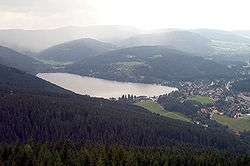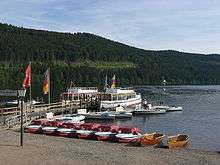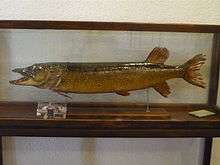Titisee
| Titisee | |
|---|---|
 View from the Hochfirst | |
| Location | South Black Forest |
| Coordinates | 47°54′N 8°09′E / 47.900°N 8.150°ECoordinates: 47°54′N 8°09′E / 47.900°N 8.150°E |
| Primary inflows | Seebach |
| Primary outflows | Gutach |
| Catchment area | 24.2 km2 (9.3 sq mi)[1] |
| Basin countries | Germany |
| Max. length | 1.87 km (1.16 mi)[1] |
| Max. width | 750 m (2,460 ft)[1] |
| Surface area | 1.07 km2 (0.41 sq mi)[1] |
| Average depth | 20.5 m (67 ft)[1] |
| Max. depth | 39.0 m (128.0 ft)[1] |
| Water volume | 22,500,000 m3 (790,000,000 cu ft)[1] |
| Surface elevation | 845 m (2,772 ft) |
| Settlements | Titisee-Neustadt |
The Titisee is a lake in the southern Black Forest in Baden-Württemberg. It covers an area of 1.3 km² and has an average of 20 metres deep.[1] It owes its formation to the Feldberg glacier, the moraines of which were formed in the Pleistocene epoch and nowadays form the shores of the lake. The lake's outflow, at 840 m above sea level, is the River Gutach, which merges with the Haslach stream below Kappel to form the Wutach). The waters of the Titisee thus drain eventually into the Upper Rhine between Tiengen and Waldshut. On the north shore lies the spa town of the same name, today a part of the municipality of Titisee-Neustadt.[1]
Origin of the name
There are various theories about the origin of the unusual name Titisee:
- In the Alemannic dialect Teti minds "little child" or "baby". A Tetisee or Titisee would then be a lake from which, according to local legend, small children came, similar to the story told in other places that babies are delivered by a white stork. Stories about babies coming from lakes were widespread in Central Europe (c.f. Frau-Holle-Teich). Consistent with this theory, is the fact that the Titisee is a very high altitude lake and that, also according to legend, it is bottomless. Such lakes were formerly attributed with special numinous powers.[2]
- According to another theory, the Roman general, Titus, was supposed to have camped in the area of the Titisee. The lake was said to have impressed him so much that he gave his name to it. This is also the reason why, today, a crude replica of a Roman galley plies the Titisee.
- According to a legend a nobleman called Titini hunted in the area around the lake in the 12th century.
- Also the arum lily, formerly known in the region as the Tittele, could be the origin of the name, even though it no longer occurs by the Titisee.
History

In 1840, two sarcophagi made of worked tuff were found below a knoll by the outflow of the Gutach from the Titisee. In 2011, the archaeologist, Andreas Haasis-Berner, published an article stating that they had to date to the period between 700 and 900 A.D. Hitherto, it had been thought that the High Black Forest had been unsettled during the first millennium.[3][4]
The first records of the lake date to the year 1050 A.D. and the abbey of Allerheiligen in Schaffhausen, where the name Titinsee is mentioned. The name Dettesee is also mentioned in a deed from the parish of Saig that dates to 1111 A.D. The name of the lake adopted its present from around 1750.
Winter freezing
The Titisee takes a long time to freeze over in the winter owing to the winds, which keep the surface of the water moving almost all continuously. For the frozen lake to be opened for use, it must have a solid ice thickness of at least 16 cm (solid ice or compacted ice has virtually no air pockets). When conditions appear favourable for the opening the lake, daily ice measurements are taken by the Titisee-Neustadt municipal authorities at three or four places. If opening the ice to public use is possible, and those responsible give it their blessing, specific, demarcated areas of the lake are opened, but never the whole lake.
These regulations were put in place after an accident in 1966. Up to that time, the lake had been used in winter as a landing strip for small aircraft. On 14 Jan 1966, a tractor with a snowplough was clearing the landing strip of snow when it broke through the ice and sank to the bottom of the lake, taking the driver, Walter Wilde (29), with it. His body was only recovered 2 weeks later.[5]

Fauna and flora

In the nutrient-poor Titisee there are large predatory fish (ubfische (pike-perch, sea trout and a large stock of pike), schooling fish (whitefish, roach and perch) as well as carp, chub and tench in shallower areas. This variety of species is joined by brown trout, char and rainbow trout where the streams enter the lake, and by eels and burbot on the lake bed. In addition there are small fish varieties such as sunbleak, minnow and brook lamprey. Around the lake, grey heron may be seen.
The shores of the Titisee are home to two rare types of quillworts, the spring quillwort and the lake quillwort.[6]
Photo gallery
- View over Titisee and the resort of the same name (2004)
 View over Titisee from the south (postcard, about 1909)
View over Titisee from the south (postcard, about 1909) North shore with boat rental
North shore with boat rental- Pier for a touring boat that circles the lake. Winter scene
References
- 1 2 3 4 5 6 7 8 9 Documentation on the Condition and Development of the Most Important Lakes in Germany: Part 10, Baden-Württemberg (pdf; 411 KB)
- ↑ Artikel Kinderherkunft, Handwörterbuch des deutschen Aberglaubens, Berlin, 2006, Digitale Bibliothek 145, Directmedia, p. 1,350.
- ↑ Andreas Haasis-Berner: Das Rätsel vom Titisee, In: Archäologische Nachrichten aus Baden, Heft 80/81
- ↑ Peter Stellmach: Titisee-Neustadt: Die Stadt hätte ums Haar das 900. Jubiläum verpasst: Schnell, schnell, Titisee feiert doch Geburtstag!, Badische Zeitung, 25 February 2011, retrieved 23 June 2011
- ↑ Hans Schmider (2004) (in German), Titisee-Chronik – Die Geschichte des Titisees und seiner Anwohner, Titisee-Neustadt: Selbstverlag Hans Schmider
- ↑ Richard Pott (1996) (in German), Biotoptypen : Schützenswerte Lebensräume Deutschlands und angrenzender Regionen, Stuttgart (Hohenheim): Ulmer, pp. 55, ISBN 978-3-8001-3484-7
External links
| Wikimedia Commons has media related to Titisee. |
- Nixdorf, B.; et al. (2004), "Titisee" (PDF), Dokumentation von Zustand und Entwicklung der wichtigsten Seen Deutschlands (in German), Berlin: Umweltbundesamt, p. 29
- Webcam
- Municipality Homepage
- Titisee: Tourism information